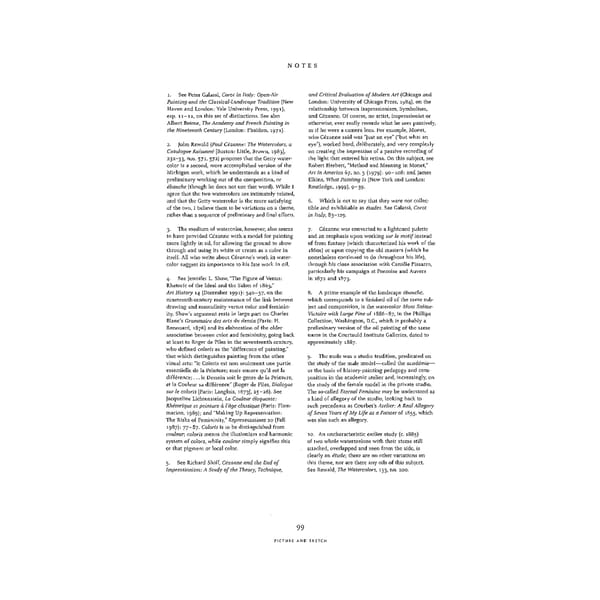NOTES 1. See Peter Galassi, Corot in Italy: Open-Air and Critical Evaluation of Modern Art (Chicago and Painting and the Classical-Landscape Tradition (New London: University of Chicago Press, 1984), on the Haven and London: Yale University Press, 1991), relationship between Impressionism, Symbolism, esp. 11-12, on this set of distinctions. See also and Cezanne. Of course, no artist, Impressionist or Albert Boime, The Academy and French Painting in otherwise, ever really records what he sees passively, the Nineteenth Century (London: Phaidon, 1971). as if he were a camera lens. For example, Monet, who Cezanne said was "just an eye" ("but what an 2. John Rewald (Paul Cezanne: The Watercolors, a eye"), worked hard, deliberately, and very complexly Catalogue Raisonne [Boston: Little, Brown, 1983], on creating the impression of a passive recording of 232-33, nos. 571, 572) proposes that the Getty water- the light that entered his retina. On this subject, see color is a second, more accomplished version of the Robert Herbert, "Method and Meaning in Monet," Michigan work, which he understands as a kind of Art in America 67, no. 5 (1979): 90-108; and James preliminary working out of the composition, or Elkins, What Painting Is (New York and London: ebauche (though he does not use that word). While I Routledge, 1999), 9-39. agree that the two watercolors are intimately related, and that the Getty watercolor is the more satisfying 6. Which is not to say that they were not collec- of the two, I believe them to be variations on a theme, tible and exhibitable as etudes. See Galassi, Corot rather than a sequence of preliminary and final efforts. in Italy, 83-129. 3. The medium of watercolor, however, also seems 7. Cezanne was converted to a lightened palette to have provided Cezanne with a model for painting and an emphasis upon working sur le motif instead more lightly in oil, for allowing the ground to show of from fantasy (which characterized his work of the through and using its white or cream as a color in i86os) or upon copying the old masters (which he itself. All who write about Cezanne's work in water- nonetheless continued to do throughout his life), color suggest its importance to his late work in oil. through his close association with Camille Pissarro, particularly his campaign at Pontoise and Auvers 4. See Jennifer L. Shaw, "The Figure of Venus: in 1872 and 1873. Rhetoric of the Ideal and the Salon of 1863," Art History 14 (December 1991): 540-57, on the 8. A prime example of the landscape ebauche, nineteenth-century maintenance of the link between which corresponds to a finished oil of the same sub- drawing and masculinity versus color and feminin- ject and composition, is the watercolor Mont Sainte- ity. Shaw's argument rests in large part on Charles Victoire with Large Pine of 1886-87, in the Phillips Blanc's Grammaire des arts du dessin (Paris: H. Collection, Washington, D.C., which is probably a Renouard, 1876) and its elaboration of the older preliminary version of the oil painting of the same association between color and femininity, going back name in the Courtauld Institute Galleries, dated to at least to Roger de Piles in the seventeenth century, approximately 1887. who defined colons as the "difference of painting," that which distinguishes painting from the other 9. The nude was a studio tradition, predicated on visual arts: "le Coloris est non seulement une partie the study of the male model—called the academie— essentielle de la Peinture; mais encore qu'il est la as the basis of history-painting pedagogy and com- difference;... le Dessein soit le genre de la Peinture, position in the academic atelier and, increasingly, on et la Couleur sa difference" (Roger de Piles, Dialogue the study of the female model in the private studio. 2 2 The so-called Eternal Feminine may be understood as sur le colons [Paris: Langlois, 1673], 5~ 6)- See Jacqueline Lichtenstein, La Couleur eloquente: a kind of allegory of the studio, looking back to Rhetorique et peinture a I'age classique (Paris: Flam- such precedents as Courbet's Atelier: A Real Allegory marion, 1989); and "Making Up Representation: of Seven Years of My Life as a Painter of 1855, which The Risks of Femininity," Representations 20 (Fall was also such an allegory. 1987): 77-87. Coloris is to be distinguished from couleur, colons means the illusionism and harmonic 10. An uncharacteristic earlier study (c. 1885) system of colors, while couleur simply signifies this of two whole watermelons with their stems still or that pigment or local color. attached, overlapped and seen from the side, is clearly an etude; there are no other variations on 5. See Richard Shiff, Cezanne and the End of this theme, nor are there any oils of this subject. Impressionism: A Study of the Theory, Technique, See Rewald, The Watercolors, 133, no. 200. 99 PICTURE AND SKETCH
 Cézanne in the Studio: Still Life in Watercolors Page 113 Page 115
Cézanne in the Studio: Still Life in Watercolors Page 113 Page 115